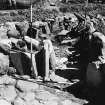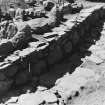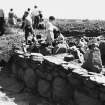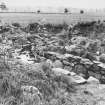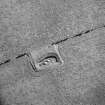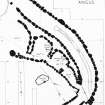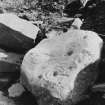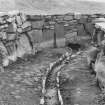Pricing Change
New pricing for orders of material from this site will come into place shortly. Charges for supply of digital images, digitisation on demand, prints and licensing will be altered.
Ardestie, Earth House
Cup Marked Stone (Neolithic), Settlement (Iron Age), Souterrain (Iron Age)
Site Name Ardestie, Earth House
Classification Cup Marked Stone (Neolithic), Settlement (Iron Age), Souterrain (Iron Age)
Alternative Name(s) Mains Of Ardestie
Canmore ID 34572
Site Number NO53SW 1
NGR NO 50205 34446
Datum OSGB36 - NGR
Permalink http://canmore.org.uk/site/34572
First 100 images shown. See the Collections panel (below) for a link to all digital images.
- Council Angus
- Parish Monikie
- Former Region Tayside
- Former District Angus
- Former County Angus
NO53SW 1 5030 3444.
(NO 5030 3444) Souterrain (NR)
OS 1:10,000 map, (1974).
The Ardestie souterrain, discovered in February 1949, and excavated by Wainwright between February 1949 and June 1950, revealing a robbed but recognisable complex of surface huts, etc, associated with the souterrain, as well as evidence of post-souterrain occupation.
A cup and ring marked stone was found in the wall of one of the huts. Full report with plans and illustrations.
F T Wainwright 1953; 1963.
NO 5135/5136 and NO 5034 A copper alloy ball with a hole pierced in one end, 3.5cm in diameter, was discovered in the vicinity of a souterrain in the Carlungie/Ardestie area, as a surface find. It was brought in as a verbal enquiry to Montrose Museum in 1994 and to Glasgow Museums in January 1995. It was retained by the finder. Glasgow Museums Enquiry Number 1306.
R Benvie 1995
This paper considers the evidence for the abandonment of souterrains in that part of east central Scotland characterized by Wainwright as 'southern Pictland'. The evidence suggests that most souterrains were deliberately destroyed, or at least infilled, and that none seems to have outlasted the early 3rd century AD. The process of destruction seems to have been associated with a significant degree of ritual activity not previously noted. It is postulated that the evidence would allow for a single episode of abandonment (a 'souterrain abandonment horizon'), in the late second or early third century AD, which might be related to a major reorientation of social and political structures, perhaps associated with changes in Roman frontier policy.
I Armit 1999
NO 5020 3444 A watching brief was maintained at Ardestie Souterrain, on two separate visits in February 2007, during the excavation of two small trenches, one for a new entrance gate and the other for the relocation of an information board. There were no finds or features of archaeological significance.
Archive to be deposited with RCAHMS.
Funder: Historic Scotland.
Sarah Hogg, 2007.
Excavation (1949 - 1950)
The Ardestie souterrain, discovered in February 1949, and excavated by Wainwright between February 1949 and June 1950, revealing a robbed but recognisable complex of surface huts, etc, associated with the souterrain, as well as evidence of post-souterrain occupation.
A cup and ring marked stone was found in the wall of one of the huts. Full report with plans and illustrations.
F T Wainwright 1953; 1963.
Aerial Photography (September 1970)
Oblique aerial photographs of Ardestie souterrain, Angus, taken by John Dewar in September 1970.
Publication Account (1987)
This souterrain was discovered as a result of stone clearance in 1949 and excavated by Dr FT Wainwright in 1949 and 1950. The shape of the souterrain was compared by Wainwright to that of a banana, with the entrance forming the stalk and the main curved chamber the banana itself. The short narrow passage leads down to the twin jambs of the entrance doorway; the souterrain was constructed with massive boulders at the base of the corbelled side-walls and with rougher stone-work, now partly reconstructed, forming the upper courses. Large flat slabs formed an irregular paving with a central drain for about two-thirds of its length. The drain was not an original feature of the souterrain construction, but was essential because the surrounding boulder clay did not allow water to run off naturally. But even the drain was not sufficient, and the souterrain was eventually abandoned; the roof and the upper courses of the wall appear to have been removed and the passage filled with earth.
Four surface structures, which were in use at the same time as the final phase of use of the souterrain, are visible on its south-west side. Only part of the northwest structure survives, but part of a broken rotary quern was found in the floor and a large cup-and-ring marked slab was found set into the wall. In the north-east corner of the adjacent structure there was a stone bench comprising a large flat slab supported by uprights; apart from another quern fragment, sherds and animal bones were found. The major feature of the third structure was a 'fire-bowl' with a well preserved 'draught-vent' underneath the paving; among the debris was part of a Roman amphora and a pitted stone, which was probably used to produce fire. A narrow structure led from this series of surface buildings directly to the souterrain itself but it is likely that this and the adjacent structure were not in use after the souterrain was filled in. A stone-lined tank originally lined with clay in order to make it watertight may still be seen a little to the south.
Just how the souterrain and the surface structures should be interpreted in the light of the evidence from Newmill discussed in the Introduction is uncertain; on the one hand it seems not improbable that the roof of the souterrain itself was of timber rather than flat slabs, on the other hand the sophistication of the timber house at Newmill makes it unlikely that the surface features at Ardestie were roofed with individual timber and thatch wigwams as is sometimes suggested as a reconstruction. Another interpretation might be that the surface structures indicate paved industrial areas just outside the main roofed area involving activities that were perhaps hazardous (the 'fire-bowl') or noxious (a stone bench associated perhaps with butchery).
Information from ‘Exploring Scotland’s Heritage: Fife and Tayside’, (1987).
Watching Brief (February 2007)
NO 5020 3444 A watching brief was maintained at Ardestie Souterrain, on two separate visits in February 2007, during the excavation of two small trenches, one for a new entrance gate and the other for the relocation of an information board. There were no finds or features of archaeological significance.
Archive to be deposited with RCAHMS.
Funder: Historic Scotland.
Information from Sarah Hogg (Kirkdale Archaeology) , 6 March 2007.
OASIS ID - kirkdale1-249618


















































































































